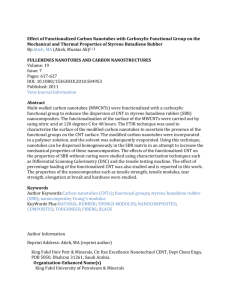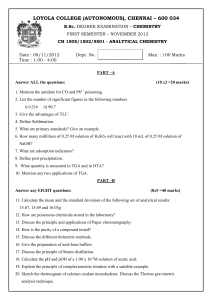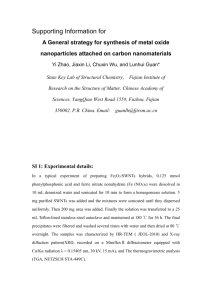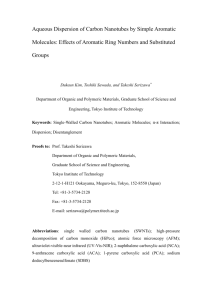supportinginfo_tcne
advertisement
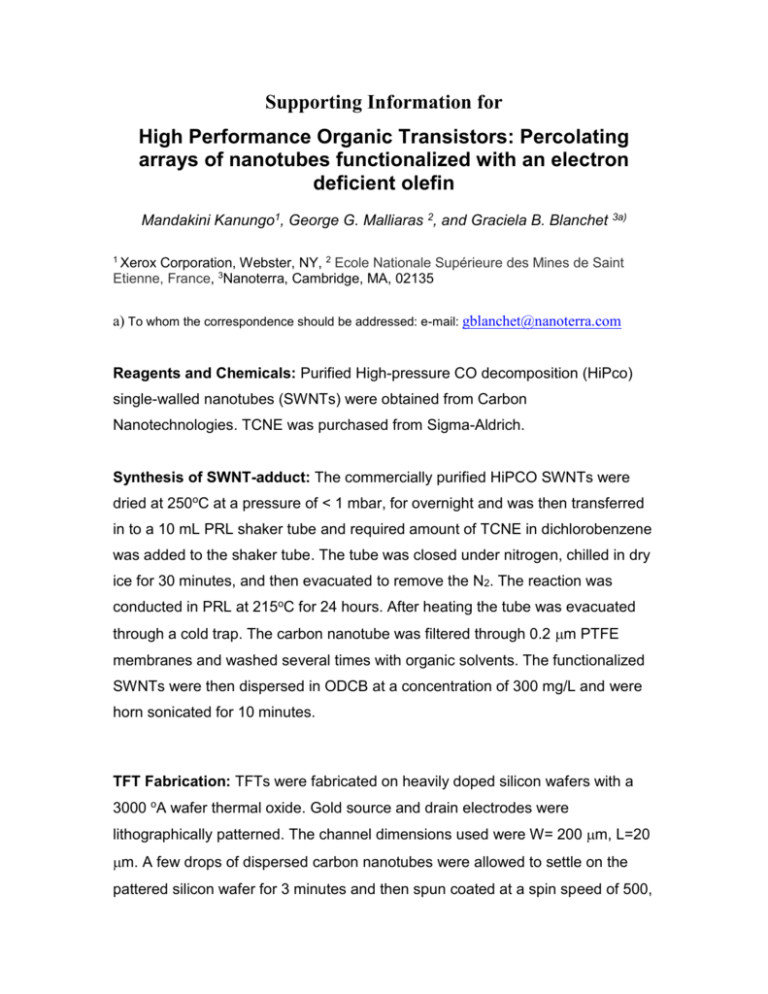
Supporting Information for High Performance Organic Transistors: Percolating arrays of nanotubes functionalized with an electron deficient olefin Mandakini Kanungo1, George G. Malliaras 2, and Graciela B. Blanchet 3a) 1 Xerox Corporation, Webster, NY, 2 Ecole Nationale Supérieure des Mines de Saint Etienne, France, 3Nanoterra, Cambridge, MA, 02135 a) To whom the correspondence should be addressed: e-mail: gblanchet@nanoterra.com Reagents and Chemicals: Purified High-pressure CO decomposition (HiPco) single-walled nanotubes (SWNTs) were obtained from Carbon Nanotechnologies. TCNE was purchased from Sigma-Aldrich. Synthesis of SWNT-adduct: The commercially purified HiPCO SWNTs were dried at 250oC at a pressure of < 1 mbar, for overnight and was then transferred in to a 10 mL PRL shaker tube and required amount of TCNE in dichlorobenzene was added to the shaker tube. The tube was closed under nitrogen, chilled in dry ice for 30 minutes, and then evacuated to remove the N2. The reaction was conducted in PRL at 215oC for 24 hours. After heating the tube was evacuated through a cold trap. The carbon nanotube was filtered through 0.2 m PTFE membranes and washed several times with organic solvents. The functionalized SWNTs were then dispersed in ODCB at a concentration of 300 mg/L and were horn sonicated for 10 minutes. TFT Fabrication: TFTs were fabricated on heavily doped silicon wafers with a 3000 oA wafer thermal oxide. Gold source and drain electrodes were lithographically patterned. The channel dimensions used were W= 200 m, L=20 m. A few drops of dispersed carbon nanotubes were allowed to settle on the pattered silicon wafer for 3 minutes and then spun coated at a spin speed of 500, 1000 and 2000 rpm. Electrical properties were measured using a standard Agilent unit. A voltage of 0.01V to 1V was applied between source and drain electrodes and the gate voltage were swept from 50V to -100V while measuring the drain current. AFM Characterization: AFM height and phase images of the purified and functionalized SWNTs were obtained in tapping mode in air at resonance frequencies of 50-75 kHz with oscillating amplitudes of 10-100 nm. The AFM images were obtained using conventional Si tip (k= 3-6N/m) with a Veeco Metrology Nanoscope IV (Digital instruments, Santa Barbara, CA) Separation of the reactants on carbon nanotube sidewalls by TGA and XPS: The separation of the reactants on the carbon nanotube walls was estimated from the thermal gravimetric analysis (TGA) X-ray Photoelectron Spectroscopy (XPS) data. For TGA the samples were purged with nitrogen for 2 hours before the start of the run. The TGA was carried out in a TGA Q500 v6.6 Build 197 instrument. The sample was heated from room temperature to 1000 oC at 10 oC under nitrogen. The mass loss below 750 oC was assumed associated to the reactant and that loss above 750 oC with the unreacted CNT. Sample: FSWNT-TCNE (II) CNT Size: 1.9490 mg Method: ISO120 RT to1000°C@10°C N2 Comment: N2 / Blanchet / Job# 270732 File: C:...\Blanchet, Graciela\788216.ug1 Operator: Ken Roth Run Date: 17-Oct-2008 18:36 Instrument: TGA Q500 V6.6 Build 197 TGA 120 0.4 11.57% wt. loss RT to 332°C in N2 (0.2255mg) 0.3 Weight (%) 32.25% wt. loss 332°C to 549°C in N2 (0.6285mg) 0.2 13.94% wt. loss 549°C to 996°C in N2 (0.2718mg) 80 Residue: 42.52% at 996°C (0.8286mg) 0.1 60 [ – – – – ] Deriv. Weight (%/°C) 26.40°C 100.3% 100 0.0 40 0 200 400 600 Temperature (°C) 800 Figure 1: TGA of TCNE functionalized HiPco tubes -0.1 1000 Universal V4.2E TA Instruments TGA data show that 90% of the carbon nanotubes have reacted by 600 oC for all compositions with c>0.007. The decomposition/oxidation appears to occur readily and indiscriminately. In contrast, only 40% of the SWNT reacted upon PSEPVE functionalization perhaps reflecting that the small molecular size of TCNE compared to PSEPVE allows not only more reaction sites on carbon nanotubes walls thus helping in shortening of the tubes but perhaps also enter the tubes. We proposed that chain cleavage occurs via the radical mechanism shown below. In this scheme, the cyclobutyl ring undergoes a reverse cycloaddition reaction and the tubes get open up at that site creating more reactant sites and at the same time shortening the tubes. Scheme 1: Proposed radical mechanism for chain cleavage Measuring the lengths of some 200 ropes in each of seven AFM picture associated with different concentrations we are able to correlated average chain length with mobility as shown in figure 2. The roughly constant vertical shift of one curve with respect to the other indicates a constant factor and hence a roughly linear dependence of mobility on chain length over the range of concentrations investigated Figure 2: Average chain length vs. mobility as a function of CTCNE/CSWNT. The TCNE functionalization to the carbon nanotubes was further confirmed by XPS. For XPS analysis the pristine and functionalized carbon nanotubes were drop dried on to a clean Si wafer. The experiments were carried out with a Physical Electronics Quantera Scanning ESCA Microprobe, using a focused (100 um) monochromatic Al X-ray (1486.6 eV) beam operated at 18 kV and 100 W. The X-ray beam is generated using an electron gun and scanned over ~1400 um x ~200 um to define the analysis area. The electron energy analyzer was operated in the constant energy mode with pass energy of 55 eV and 0.1 eV step size between points for high resolution elemental scans (typically 20 eV scan for each element). . The C1s band is also de-convoluted into three main peaks at 284.8, 286.1 and 287.3, associated to C-C, C-N (sp2) and C=N (sp3) indicating functionalization of the tubes with TCNE. x 10 4 cTCNE/cSWNT=0.007 4 8 284.8 eV 284.8 eV C-C C-C 7 6 Pos. 284.83 286.14 287.37 289.04 290.68 5 4 Sep. 0.00 1.31 2.54 4.21 5.85 %Area 71.48 15.77 4.51 3.55 3.35 4 cTCNE/cSWNT=0.066 3.5 Pos. 284.86 286.14 287.37 289.04 290.68 3 286.0 – 287.5 eV C-N 3 x 10 Sep. 0.00 1.28 2.51 4.18 5.82 %Area 49.63 20.15 18.06 6.62 3.49 C-C SP2 C-N 2 SP3 C=N 2 1 1 0 0 295 290 285 Binding Energy (eV) 280 295 Figure 3: XPS analysis of functionalized SWNTs. 290 285 280



